 Image search results - "shigabest" Image search results - "shigabest" |

The Azuchi Nobunaga Festival's main venue was here, next to Azuchi Castle (hill on right). MAP
|
|

Demonstration of matchlock guns, Azuchi Nobunaga Festival in Azuchi, Omi-Hachiman.
|
|

Misaki Shrine Fire Festival in Aisho. The shrine has a 5-meter tall pile of bamboo which is lit to make a towering inferno within the shrine grounds. Very dramatic. Also see the video at YouTube.
|
|
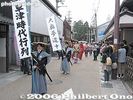
Kusatsu Shukuba Matsuri is held on April 29 to celebrate Kusatsu's history as a stage town on the Nakasendo and Tokaido Roads. The main highlight is this Kusatsu Jidai Gyoretsu procession from 11:45 am to 2 pm. This is the Tokaido Road.
|
|
|
|

Torii at Misaki Shrine Fire Festival.
|
|

Boat ride along the moat of Azuchi Castle.
|
|

Held during Aug. 3-5 at Taga Taisha Shrine, the Mantosai or 10,000-Lantern Festival is a night festival when numerous lanterns are lit within the shrine grounds. The lanterns are for the repose of ancestral spirits.
|
|

Front view of Anegawa River Battle Memorial where Oda Nobunaga and Tokugawa Ieyasu defeated Azai Nagamasa and the Asakura clan on Aug. 9 1570.
|
|

Kusatsu Shukuba Festival, Shiga Pref.
|
|

At the foot of Azuchi, the boat ride was very popular and cheap.
|
|

Practice horse track at JRA Ritto Training Center in Ritto.
|
|

Taga Taisha's lanterns come in five sizes. Each one represents a donation. The donar's name is on the lantern. The biggest lantern requires a donation of 20,000 yen.
|
|

Statue of Ishida Mitsunari at his former residence in Nagahama.
|
|

Anegawa River ran red with the blood of fallen warriors in Aug. 1570.
|
|

The torches burn within seconds.
|
|

The fire at its peak was very hot to the skin. Sumiyoshi Shrine Fire Festival, Moriyama, Shiga in late Jan.
|
|

View of Ryuo-cho town from Mt. Yukinoyama.
|
|

Direct path to Taga Taisha Shrine hall
|
|

On the other side of this Anegawa River were Oda Nobunaga's forces.
|
|

Lanterns at night
|
|

Sumiyoshi Shrine Fire Festival, Moriyama, Shiga Pref. on the second Sat. of January.
|
|

Oda Nobunaga at Azuchi Nobunaga Matsuri. 織田信長
|
|
|

Chojuji temple Hondo temple hall, National Treasure in Konan, Shiga.The hondo once burned down, but was rebuilt during the Kamakura Period.
|
|

May 27, 2007 was a bad day for giant kite flying in Yokaichi, as the giant kite crashes head-first into a bamboo grove on its first and last flight during the Yokaichi Giant Kite Festival.
|
|

View of central Ryuo-cho town from Mt. Yukinoyama.
|
|

Wada Tumuli is the group of nine small tumuli in Ritto. 和田古墳群 MAP
|
|

At slightly past noon with medium-force winds, the giant kite is launched. The kite immediately went straight up. The giant kite is 13 meters high and 12 meters wide, and weighs 700 kg.
|
|

Tumulus No. 5 with a reconstructed chamber made of stone in Ritto.
|
|

Kusatsu Shukuba Festival, Shiga Pref.
|
|

The tumuli in Ritto are estimated to have been built during the 6th to 7th centuries.
|
|

Chojuji temple Hondo temple hall, National Treasure
|
|

View of Ritto from Mt. Anyoji.
|
|

View from Mt. Anyoji in Ritto.
|
|

Jorakuji Hondo hall, a National Treasure in Konan, Shiga. The pagoda on the left is also a National Treasure. The original temple burned down in 1360, and rebuilt the same year.
|
|

Kusatsu-juku Honjin. the Honjin was the town's most luxurious accommodation catering to society's elite like daimyo warlords, Imperial family members including the emperor, and other dignitaries. National Historic SiteAt stage towns along the major roads like the Nakasendo and Tokaido, the Honjin was the town's most luxurious accommodation catering to society's elite like daimyo warlords, Imperial family members including the emperor, and other dignitaries. It operated during 1635 to 1870. The Honjin is now a museum.
This Honjin in Kusatsu is a very impressive example of traditional architecture. It is designated as a National Historical Place. It underwent a complete renovation and reconstruction during 1989 to 1995. (In case you wonder why such an old building looks so new.) Admission 200 yen. 10-min. walk from Kusatsu Station.
|
|

Water intake for Lake Biwa Canal No. 2. The canal is covered. The water supply for Kyoto and Osaka.
|
|

Biwako Sosui. The city of Otsu is thinking about resurrecting a tourist boat service on this canal. MAP
|
|

Lake Biwa Canal (Biwako Sosui) and cherry blossoms. This is one of two canals which supply water from Lake Biwa to Kyoto. National Historic Site
|
|

Lake Biwa Canal and cherry blossoms in full bloom. They also light up the trees at night from 6:30 pm-9:30 pm. Beautiful and serene.
|
|

Lake Biwa Canal and cherry blossoms.
|
|

No. 1 Tunnel entrance. The first and longest tunnel under a mountain. The entrance is very artistic.
|
|

Temple roof of Jorakuji temple.
|
|

View of Lake Biwa from Nishinomaru on Mt. Hachimanyama in Omi-Hachiman.
|
|

Jodan no Ma - Kusatsu-juku Honjin. The Gyokuza raised tatami mats was where the lord or Emperor slept or sat. 上段の間Reserved for daimyo warlords, emperors, etc.
|
|

Jorakuji's Three-story pagoda is also a National Treasure Built in 1400.
|
|

Nishi-no-ko Lake as seen from Kitanomaru atop Mt. Hachiman-yama.
|
|
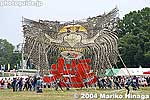
Yokaichi giant kite coming up.
|
|

Yokaichi Odako giant kite Air borne
|
|

Site of Hachiman-yama Castle in Omi-Hachiman.
|
|

View of Omi-Hachiman city center from Mt. Hachiman-yama.
|
|

View of Mt. Mikami-yama amid rice paddies in Yasu. Elevation 432 meters.
|
|
|

Cherry blossoms along Seta River in Otsu, Lake Biwa's only outflowing river.
|
|

Cherry blossoms and Tahoto pagoda at Ishiyama-dera.
|
|

Ishiyama-dera's Hondo Hall, a National Treasure. 本堂
|
|

Inside Ishiyama-dera's Hondo Hall 本堂
|
|

At Ishiyama-dera, inside Room of Genji is a lifesize doll of Lady Murasaki Shikibu who wrote Tale of Genji, one of Japan's most famous novels.
|
|

Lady Murasaki supposedly wrote the novel in this room at Ishiyama-dera in Otsu.
|
|

Finally we see Ishiyama-dera's beautiful Tahoto pagoda, a National Treasure in Otsu.
|
|

The Tahoto was built in 1194 upon the patronage of Minamoto Yoritomo. It is Japan's oldest Tahoto and one of the three most famous ones.
|
|

Ishiyama-dera's Moon-viewing Pavilion and cherry blossoms. Not open to the public. 月見亭
|
|

About the Asahi Honen Taiko Odori. It originated in the latter 7th century in Ohara village when they started to cultivate new farming land. It was a rainmaking dance. Now held in Oct. in Maibara.
|
|

With Mt. Ibuki in the background, the Asahi Honen Taiko Odori dance troupe head for Hachiman Shrine.
|
|

Asahi Honen Taiko Odori dancers and Mt. Ibuki in Maibara, Shiga.
|
|

Asahi Honen Taiko Odori dance in Maibara, Shiga.
|
|

Lookout point on Mt. Mikami in Yasu.
|
|

View from Mt. Mikami, Yasu. Ishibe is toward the left.
|
|

View from Mt. Mikami, Yasu.
|
|

Chawan Matsuri Hana-yakko flower umbrella dancers. They wear a Nagajuban kimono slip (長襦袢) and straw sandals. 花奴
|
|

The fantastic things about the festival floats is that they all have 10-meter high "balancing act" decorations depicting kabuki characters and legends. The decoration is made by a team of three craftsmen whose techniques are secret.
|
|

Nagahama Castle, Shiga
|
|

Plaque proclaiming Hokoen Park as one of Japan's 100 Best Cherry Blossom Spots.
|
|

The floats don't look too heavy to pull at all.
|
|

Shiga governor Kada Yukiko (wearing a light green jacket on the right) pulling a festival float at the Chawan Matsuri in Yogo. The man next to her was shouting, "Banzai!" 滋賀県知事 嘉田由紀子
|
|
|
|
|

I visited the park in April 2009 in the early morning before the crowds arrived. It truly was a peaceful beauty.
|
|

Nagahama Castle tower, local history museum.
|
|

In spring.
|
|

Third dance called Ogi-no-Mai (Folding Fan Dance), he holds a folding fan and a gohei sacred staff. 稚児の舞 扇の舞
|
|

Nagahama Castle and cherry blossoms.
|
|

Stone foundation of original Nagahama castle tower. It is just slightly behind the current castle building is this small hill with stone walls.
|
|

On Oct. 25-26, 2008, the first Yuru-Kyara (Mascot Character) Matsuri was held on Yume-Kyobashi Castle Road in Hikone. This sign at Hikone Station points the way. Map
|
|

About 46 mascots showed up during the two days. I went on the first day. They are called "yuru-kyara" (ゆるキャラ) in Japanese which means "loose characters." (Don't ask me what that means.)
|
|

Namu-kun from Nara to celebrate the 1300th anniversary of Nara. "Namu" is based on "Namu Amida butsu" and "Namu Horengekyo." なーむくん (奈良 奈良市)
|
|

Otsu Hikaru-kun from Otsu, Shiga to promote the 1000th anniversary in 2008 of the novel Genji Monogatari written in Ishiyama-dera temple in Otsu. おおつ光ルくん (滋賀 大津市)
|
|

Humanoid mascots were the most numerous. This is Chacha-hime, based on the eldest daughter Chacha (later Lady Yodo-dono) of Lord Azai Nagamasa and Oichi (sister of Oda Nobunaga) who lived in Odani Castle in Kohoku-cho. 茶々姫
|
|

The main draw by far was Sento-kun from Nara. The place had two small stages where they introduced each mascot. A huge crowd gathered to see Sento-kun appear on stage.
|
|

Sento-kun, a boy priest with deer antlers to promote the 1300th anniversary of Nara. せんとくん (奈良 奈良市)
|
|

Hiko-nyan, the King of yuru-characters in Japan, and Tawawa-chan.
|
|
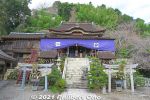
Tsukubusuma Shrine (都久夫須麻神社 National Treasure) on Chikubushima island, Nagahama, Shiga. It worships Benzaiten as well as the Dragon God and Azai-hime. Chikubushima is one of Japan's Big Three Benzaiten shrines (日本三大弁天), besi
|
|

Before-and-after photos of the corridor in front of the altar. The wooden pillars that used to be covered with pilgrim name stickers are now all gone. Pillars totally re-lacquered. 観音堂
|
|

Ceiling in front of the altar includes a red paper lantern.
|
|

Kannon-do ceiling and transom deer carvings.
|
|

Karamon Gate 唐門 (National Treasure) before it was restored in March 2020. See the next photo.
|
|

Karamon Gate looks new, but it's actually over 400 years old. "Karamon" (唐門) is a generic term for Chinese-style gates.There are other Karamon Gates in Japan, namely the more elaborate one at Nishi Hongwanji Temple in Kyoto. Karamon have colorful and intricate wood carvings and decorative features.
|
|
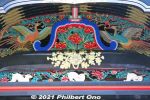
Never noticed those white rabbits before...
|
|
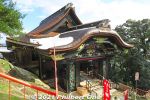
The roof was also rethatched with new cypress bark. The last time the building was reroofed was in 1972. (The white patch is snow.)
|
|

The main highlight of the festival is the Hikone Castle Festival Parade held in the afternoon of Nov. 3 (national holiday called Culture Day).
|
|

Hikone Gun Battalion dressed like Ii Clan samurai with their trademark red armor nicknamed "Red Devils."
|
|

Little Edo Hikone Castle Festival Parade
|
|

Ii Naosuke (井伊 直弼) (1815-1860) as the Tokugawa shogunate's Chief Minister (Tairo) who favored and concluded commercial treaties with the Western powers and thus broke Japan's isolation from the world.
|
|

Next are groups wearing period costumes. They are junior high schoolers.
|
|

Ii Naomasa (井伊直政) (1561-1602 ) was the first lord of Hikone from 1600. He was a general under Tokugawa Ieyasu whom he helped to win the Battle of Sekigahara in 1600. He was rewarded with the fief of Omi (now Shiga) and built Hikone Castle.
|
|

Hiko-nyan
|
|

Fireman's acrobatics is a crowd pleaser.
|
|

Before or after the castle parade, you might as well see the chrysanthemum exhibit at Gokoku Shrine (護国神社), a shrine dedicated to Shiga's war dead.
|
|

Chrysanthemum looking like Hiko-nyan.
|
|

Kogenji Temple in Takatsuki, Nagahama belongs to the Buddhist Jodo Shinshu Sect (Otani school). On the left of this main hall is the Doganji Kannon Hall where the 11-face Kannon statue (National Treasure) can be viewed. 渡岸寺観音堂(向源寺)
|
|

Dotaku Museum in Yasu, Shiga Prefecture. Opened in Nov. 1988, the museum is near the site where Japan's largest bronze bell was unearthed. It has bronze bell exhibits and research facilities. Open 9 am to 5 pm (closed Mon.). Admission 400 yen.
|
|

On Aug. 20, 1881, two young lads were playing on Mt. Oiwa when they stumbled across three dotaku partially exposed in the ground. The next day, eleven more dotaku were discovered in the same area.
|
|

The dotaku were nestled inside each other. These bells are dated from around 100 BC to 300 AD. The bells were not really used as bells. They were more for decorative and religious purposes.
|
|

Monument marking the site where the dotaku were found. It's frustrating that none of the original dotaku discovered in Yasu are in Yasu. Another case of bungling and ineptness by local officials. Even one original dotaku would make the museum busier.
|
|

Adjacent to the Dotaku Museum is a replica of a Yayoi Period village. Yayoi Period (500 BC to 300 AD) is noted as when rice growing started in Japan.
|
|

Bin-temari in Echigawa, Shiga. Echigawa's bin-temari history goes back to around 1840 when its oldest bin-temari was made. However, this traditional art died out with the death of Aoki Hiro in 1973, Echigawa's last bin-temari maker.
|
|

After Aoki's death, a temari preservation society was formed and the craft was passed on based on Aoki's husband's memory of how his wife made it. Besides Echigawa, only a few other places in Japan still make bin-temari.
|
|

The ball is actually hollow like a balloon. It is inserted into the bottle in a deflated state, then expanded into a ball. The museum also has a fascinating video showing how temari is made.
|
|

Basho Matsuo's grave at Gichuji temple, Otsu. 芭蕉の墓
|
|

Basho Matsuo's grave at Gichuji temple, Otsu. 芭蕉の墓
|
|
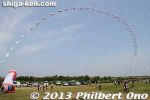
Huge arch kite of hula girls and Awa Odori dancers.
|
|

Hiko-nyan (Hikone Castle's official mascot) meets hula girls!
|
|

The hanjimon (判じもん) kite design always has a twin pair of creatures and a large kanji character. Together they form a thematic catch phrase.
|
|
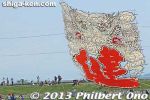
This kite's hanjimon has twin dragons that can be pronounced "shin-shin" (辰辰), a homonym for mind and body (心身). And the vermillion kanji reads "sukoyaka" (健やか), meaning good health. So the kite wishes for your "
|
|

The four Wind Goddesses pose for us. The four Wind Goddesses (風の女神) are like festival princesses and they beckon the wind to blow during the kite festival.
|
|

I was in Omi-Hachiman to see the Hachiman Matsuri fire festival on April 14. I was lucky to find the cherries in full bloom at Hachiman-bori moat on a sunny day.
|
|
|

Yakata-bune tourist boat cruising through Hachiman-bori moat in Omi-Hachiman.
|
|
|

Hachiman-bori's highest concentration of cherry blossoms is near Hakuunbashi Bridge.
|
|

Being the heart of Hachiman-bori, Hakuunbashi Bridge is where the sakura is concentrated the most. 白雲橋
|
|
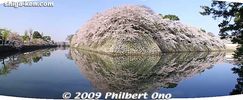
Come in the early morning and see Hikone Castle's moat water give a mirror reflection of the cherry blossoms. It's really beautiful on a sunny morning.
|
|

Hikone Castle moat and cherry blossoms.
|
|

Since the construction of Hikone Castle was designated as a national project by the Tokugawa government, as many as 12 daimyo lords were ordered to assist in the construction.
|
|

In 1606, the 1st and 2nd phases of Hikone Castle's construction were completed. The tenshu castle tower was also completed and Naokatsu moved in. This is the Castle moat and Ninomaru-Sawaguchi Tamon Yagura Turret.
|
|

Hikone Castle was built with many structures and materials transferred other Shiga castles such as Otsu Castle, Nagahama Castle, Odani Castle, Kannonji, and Sawayama Castle. This greatly reduced the cost and time required to complete the castle.
|
|

Umaya Horse Stable (Important Cultural Property).
|
|

Finally you see the main castle tower or Tenshukaku. Hikone Castle was completed in 1622 after 20 years of construction by Lord Ii Naotsugu who started building the caslte in 1603 upon his deceased father Naomasa's wish.
|
|

Hikone Castle's main tower is said to be originally the castle tower for Otsu Castle whose lord was Kyogoku Takatsugu. It was moved here in 1606. This main tower is designated as a National Treasure.
|
|

Hikone Castle is one of five main castle towers in Japan designated as a National Treasure. The others are Himeji, Matsumoto, Matsue, and Inuyama Castles.
|
|

During 1957 to 1960, this castle tower was disassembled and repaired.
|
|

Many daimyos assisted during the early phase. Most of the structures and stones came from defunct castles in Omi like Otsu, Nagahama, Odani, and Sawayama to reduce the construction time and cost.
|
|

Although it was a military fortress, Hikone Castle never saw battle and was mainly a symbol of authority.
|
|

Hikone was important as the crossroads of the Nakasendo Road (中山道) to Kyoto and Hokurikudo Road (北陸道) to the northwest. It also linked the roads to boat transportation on Lake Biwa for Kyoto.
|
|

Ceiling of Hikone Castle tower.
|
|

Headquarters of the Tendai Buddhist sect, Enryakuji is a large complex of temples, halls, buildings, and monuments on Mt. Hiei in Otsu, Shiga Prefecture. It boasts buildings which are National Treasures. MAP
|
|

Enryakuji has three temple complexes. The main and largest one is called Todo (Toto 東塔) seen on the left on this map. On the right is the Saito temple complex. The summit has a tourist attraction called Garden Museum Hiei which is not part of Enryakuj東塔, 西塔, 横川
|
|

Konpon Chudo Hall is a National Treasure and Enryakuji's main worship hall and largest building. It enshrines Yakushi Nyorai, the buddha of healing and health. 根本中堂
|
|

Kompon Chudo temple
|
|

Minami Sanno Matsuri Festival is held annually on April 4 by Hieda Jinja Shrine in Okubo and Seon (大窪、清雲). 南山王の祭 Map
|
|

Minami Sanno Matsuri Festival in Hino, Shiga.
|
|

Held annually during May 2 and 3, the Hino Matsuri is the largest festival in eastern Shiga Pref. In 2006, sixteen ornate floats and three portable shrines were paraded through the streets. It is the spring festival of the Umamioka Watamuki Shrine.
|
|

May 3, 2006: Hino Matsuri at Umamioka Watamuki Shrine 本祭(馬見岡綿向神社)Map
|
|

One by one, all the floats gather at the shrine.
|
|

Each float has a decoration on the roof depicting a popular topic during the past year. This is Yamauchi Kazutoyo and wife Chiyo from the NHK Taiga Drama called "Komyo ga Tsuji.""Komyo ga Tsuji" is about a up and coming samurai named Yamauchi Kazutoyo and his wife Chiyo who was from Shiga. The story's main setting is Shiga, and the year-long TV series was broadcast during 2006.
|
|

Ito Miki, a member of Japan's moguls team at the Turin Winter Olympics, is from Hino.
|
|

Special viewing window called "sajiki-mado" at Hino Matsuri. They view the Hino Festival procession from this special window. 桟敷窓
|
|
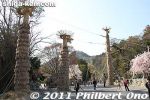
Hachiman Matsuri in Omi-Hachiman is Shiga Prefecture's biggest fire festival. Impressive even without the fire. Just look at these giant torches made of rice straw. There are more in front of Himure Hachimangu Shrine.
|
|

The giant torches can be as high as 10 meters. They are made on the Sunday before April 14-15 when the festival is held. So these torches have been here since Sunday. In front of Taneya.
|
|
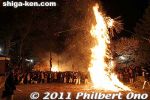
Another torch burns. One after another, they set the giant torches on fire.
|
|
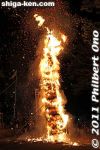
Soon the entire torch burns.
|
|

Entrance and torii to Hinade Shrine with banners announcing the sumo festival held on the third Mon. of September in Maibara.
|
|

The shrine also has a sumo ring. In the 13th century, Emperor Go-Toba visited the shrine and watched sumo performed by the local people. He offered a yellow cow to the shrine. This was the start of the shrine's annual sumo festival.
|
|
|
|

The winners received various household and kitchen goods like towels, pillows, toaster, etc.
|
|

It wasn't so crowded. There were some photographers, and it received local TV news coverage.
|
|
|

A local non-proft group called Harie Shozu-no-Sato Committee conducts tours of Harie. For 1,000 yen, they will spend 90 min. to take you to see numerous kabata in private homes. Call 0740-25-6566 to make reservations. hariekabata.comOr email: shozunosato@lapis.plala.or.jp
|
|

Most kabata have two water sinks (ike), the one on the right (tsubo-ike) is for washing summer vegetables like tomatoes, eggplants, and cucumber. The one on the left (hata-ike) is for washing dirty root vegetables like daikon, carrots, and spinach. 川端
|
|

Imagine having a spring in your own home spewing drinkable water 24/7 for free. This kabata has a few baskets. The oblong one is used for fish, and the ones on the right were used to dry bowls.
|
|

Nakajima is really nice. But right behind this scene is a neighborhood of summer homes. Also see my YouTube video here.
|
|

Soon after we got to Nakajima, this black kite flew above. I tracked it with my camera. 「ピーヒョロロロロ…」
|
|

It then swooped down to the water and I started clicking away whether it would catch a fish or not. I was delighted to see it catch this large fish and captured the moment.
|
|

What a catch. It was my first time to capture a shot like this. I love these graceful and elegant birds which have a distinct cry.
|
|

Here's a close-up of the bird's claws grasping the gills of the fish. The bird sure knows where to grab a fish. The fish had no way to escape this grip.
|
|

Map of Hiyoshi Taisha Shrine at the foot of Mt. Hiei. It is a complex of the so-called Seven Sanno Shrines, including two shrines designated as National Treasures. There are also 14 lesser shrines. Most things are within easy walking distance.
|
|

Hiyoshi Taisha's Nishi Hongu Honden Hall, a National Treasure. It is only one of three buildings in Japan which represent the Hie-zukuri (日吉造り) architectural style. Higashi Hongu and Usagu and the two other shrines in this style.西本宮 �
|
|

Hiyoshi Taisha's Sanno Torii rear view.
|
|

Hiyoshi Taisha's Higashi Hongu Shrine Honden, a National Treasure. This shrine worships the mountain god (Oyamakui-no-kami) of Mt. Hiei. Built in 1595. 東本宮 本殿 国宝
|
|

Hyozu Taisha Shrine's Japanese garden at night in fall. It's really beautiful. Like someone painted colorful autumn leaves on a black canvas.
|
|

Located in Higashi-Omi and established by Shotoku Taishi in 609, Hyakusaiji temple is Shiga Prefecture's oldest temple and one of Japan's oldest. It belongs to the Tendai Buddhist Sect. MapThe temple's terraced slope had many temple residences for hundreds of monks training here. National Historic Site
|
|

There is the 300-meter, pine tree-lined gravel path to the shrine from the first torii. MAP
|
|

Autumn leaves. In its heyday, Hyakusaiji was home to 1,300 priests, before the temple was burned by Oda Nobunaga.
|
|

It was a beautiful festival day on May 5, 2010. The Ayame girls wore colorful happi coats which really added color to the festival.
|
|

They leave here and proceed along the pine tree path to the first torii. Then they will come back here and go back and forth a few times during the festival.
|
|

Hyakusaiji's Niomon Gate with giant straw sandals
|
|

Hyakusaiji's Main temple hall (hondo). Important Cultural Property.
|
|

One feature of this festival is that someone rides on the mikoshi and detaches and raised the phoenix ornament at the top of the mikoshi.
|
|
|

Ayame girls at Hyozu Matsuri in Yasu.
|
|

Camellias and Mt. Ibuki, Maibara, Shiga Prefecture.
|
|

Snowcapped Mt. Ibuki and Mishima Pond in winter in Maibara.
|
|

Mishima Pond with Mt. Ibuki and cherry blossoms.
|
|

Mishima Pond with Mt. Ibuki and cherry blossoms.
|
|

Held only once every 5 years, the Ibuki-yama Taiko Drum Dance was held on Oct. 3, 2010 in Ueno, a small neighborhood at the foot of Mt. Ibuki.
|
|
|
|
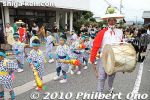
At the end of the procession are these little kids waving a wand attached to a gourd.
|
|
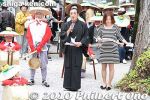
"Long ago, villagers in Ueno at the foot of Mt. Ibuki prayed for rain by doing the thunder dance by beating drums and bells, lighting torches, etc. After the rainfall and a good harvest in autumn, they danced to give thanks. This is what we are danci
|
|
|
|
|

To Mt. Azuchi where Azuchi Castle once stood in Omi-Hachiman. If you don't have a car, rent a bicycle at Azuchi Station (or ride a taxi). The castle site is not very far from Azuchi Station by bicycle.
|
|

A lot of impressive stone work remains of Azuchi Castle.
|
|

Site of Hashiba Hideyoshi's quarters at Azuchi Castle.
|
|

Azuchi Castle tower foundation stones still remain.
|
|

Notogawa giant water wheel in Higashi-Omi, Shiga. Map
|
|

Symbol of Notogawa
|
|

The famous Karasaki pine tree as seen from Lake Biwa.
|
|

Karasaki Shrine has numerous pine trees, including the famous century-old pine tree.
|
|

Omi Hakkei (Eight Views of Omi) marker at Karasaki. Omi was the old name for Shiga. A woodblock print artist depicted the Eight Views of Omi. One of them was titled, "Night Rain at Karasaki" showing the big pine in the rain at night.
|
|

Karasaki Pine Tree is the third generation tree since the original one was planted 1,400 years ago. Current pine tree was planted in 1887.
|
|

Mt. Mikami across Lake Biwa from Karasaki.
|
|

Mt. Mikami + Pine Tree at Karasaki.
|
|

Mt. Ibuki summit area with pretty patches of summer flowers.
|
|

But the scenery is great atop Mt. Ibuki in summer. 東遊歩道
|
|

Azuchi Castle tower replica at House of Nobunaga. Very ornate and beautiful. both outside and inside.
|
|

This Azuchi Castle tower replica was displayed in the Japan Pavilion at the Seville Expo '92 in Spain before it was moved here.
|
|

The unique hexagonal base of the upper section of the Azuchi Castle donjon.
|
|

Sandwiched between the foot of Mt. Mikami and Kibogaoka Bunka Park, Omi-Fuji Karyoku Koen Park (also called Omi-Fuji Green Acres) is about flowers and greenery, including cherry blossoms. 植物園
|
|

Cherry trees bloom in early April in Omi-Fuji Karyoku Koen Park (also called Omi-Fuji Green Acres), Yasu. MAP
|
|

Garden of various cherry trees.
|
|

Cherry blossoms
|
|

I visited this park after coming down from Mt. Mikami which was full of green and brown. So seeing bright colors in this park was a great sight.
|
|

Weeping cherry tree in Omi-Fuji Karyoku Koen Park (also called Omi-Fuji Green Acres) in Yasu.
|
|
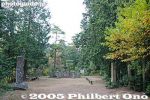
Kitabatake Tomoyuki-kyo Grave 北畠具行卿墓
|
|

Kitabatake Tomoyuki-kyo Grave. Kitabatake Tomoyuki (1290-1332) was a high-ranking Imperial Court official during the late Kamakura Period. National Historic Site 北畠具行卿墓
|
|

Held on May 3 by Tagi Jinja Shrine (龍樹神社) in Tsuchiyama, the Kenketo Matsuri Festival is highlighted by the Kenketo Odori Dance. The road to the shrine is marked with festival banners.
|
|

Kenketo Odori is a dance performed by eight boys aged 7 to 12. The dance was originally started to ward off calamities. The boys wear tall peacock feathers on their heads.
|
|

Kenketo Odori Dance at Tagi Jinja Shrine in Tsuchiyama, Shiga Prefecture.
|
|

Nagahama Bonbaiten exhibition of plum tree bonsai at Keiunkan. 長浜盆梅展
|
|
|

Katsube Fire Festival: Men dance in rings in front of the fire. Also see the video at YouTube.
|
|

Built in 1894 (Meiji 27), the Jizo statue is Japan's largest Jizo statue. 地蔵大銅像
|
|

Base of giant Jizo statue covered with frogs which help people receive divine blessings from the Jizo. 身代わり蛙
|
|

Tokugen-in temple has two weeping cherry trees. This is the older one, about 300 years old. The original cherry tree was planted by Kyogoku Doyo in the 14th century.
|
|

You can see the second weeping cherry tree in the distance. Both cherry trees are called "Doyo Sakura" since the original tree was planted by Kyogoku Doyo.
|
|

Even the second cherry tree has a beautiful shape.
|
|

Graves of the Tadotsu Clan (多度津藩), a branch of the Kyogoku who ruled in Marugame. From left to right, Kyogoku Takateru (高琢), Takakata (高賢), Takabumi (高文), Takayoshi (高慶), and Takamichi (高通). National Historic Site
|
|
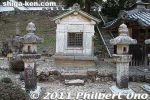
Kyogoku Takatsugu's grave.
|
|
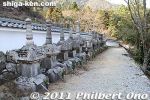
There are steps to go up the hill where there are more Kyogoku graves. These are for the older Kyogoku members, starting with the founder of the Kyogoku Clan.
|
|

Leaving Kiyotaki amid cherry blossoms in Maibara.
|
|

Konki Senshoku noren curtain. They've been in business in Konan for 200 years. One of three shops left in Shiga doing traditional indigo dyeing with natural (not synthetic) indigo dye. MAPTake a bus or taxi from Kosei or Mikumo Stations on the Kusatsu Line. Get off at Shimoda and walk 50 meters. Parking also available. Phone: 0748-75-0128, Address: Shimoda 1530, Konan-shi, Shiga
|
|

They grow their own indigo plants, dry the leaves in the sun, and extract the dye. They offer indigo dyeing lessons during which you can dye a cotton handkerchief for 1200 yen (T-shirts also). The kind lady first showed us samples of indigo fabrics.
|
|

Then we go to the indigo vats. They are heated with charcoal made with wood from trees on their hill. Each vat has a different indigo density.
|
|

We started with a vat having a low density of indigo. We dip the handkerchief for 15 sec., wring it, then expose it to the air. The indigo dye is actually a murky brownish-yellow color, but turns blue when exposed to the air.
|
|
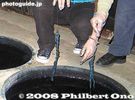
We dipped the handkerchief in multiple vats, each successive vat had a higher density of indigo. The more vats we dip the fabric in, the darker the color.
|
|

After the indigo dip, water washed the handkerchief.
|
|

Kaizu-Osaki is famous for cherry blossoms along the lake shore. One of Japan's 100 Famous Cherry Blossom Spots.
|
|

During cherry blossom season, boats often come and go at Kaizu-Osaki Port.
|
|

megumi at Kaizu-Osaki Port, Takashima, Shiga.The cruise I went on docked at the port so we could get off and walk around for 30 min. If you go on a cherry blossom cruise, go on a cruise that will dock at Kaizu-Osaki. Some cruises only cruise and do not dock.
|
|

There's a footpath along the shore.
|
|

It's really beauitful to see the cherry blossoms from the boat.
|
|
|
|